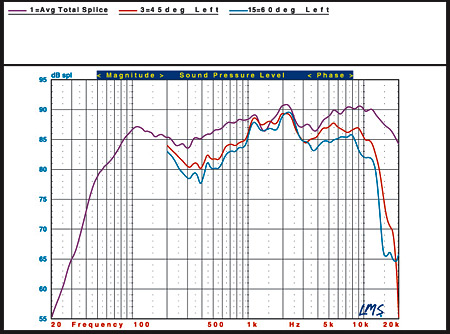Aperion Intimus 5T-DB Hybrid HD Speaker System Measurements
Text by Thomas J. Norton
The measurements shown were taken with the grilles removed. The measured responses with the grilles in place (not shown) were generally inferior, but more so with the 5C, where a reduction in energy in the 4-9kHz region with the grille on left the rise at 9-11kHz more isolated and thus more likely to be audible. The nominal impedances were determined from interpretation of the measured impedance curves (not shown).
All figures: Violet curve: pseudo-anechoic response on the tweeter axis, averaged across a 30° horizontal window, combined with nearfield responses of the woofer(s) and port (or, in the 5C, the passive radiator). All measurements were taken at one meter.
5T
Minimum impedance: 5.44Ω at 45Hz
Nominal impedance: 6Ω
Cabinet tuning: 45Hz
Effective bass extension (-10dB): 38.5Hz (reference level 100Hz)
Sensitivity: 87dB/2.83V/m
The 5T should be a relatively easy load to drive. The impedance is unusually uniform once you get above the bass-loading region, and the impedance phase angle is benign. At higher frequencies, the impedance does drop to a slightly lower value than that shown above (5.33Ω at 9kHz). However, the impedance at higher frequencies is less significant (within reason) to an amplifier's ability to comfortably drive a speaker.

Fig.1: 5T, pseudo-anechoic response, off-center in the horizontal plane, at 45° (red) and 60° (blue).
The measured response of the 5T is relatively smooth, though it rises to a plateau that's up by 2-3dB across much of the region above 800Hz. The bass response rolls off rapidly below about 70Hz, though with useful response below that frequency. Some music listeners might find the speaker's inherent bass response to be perfectly fine unless their tastes tend toward a lot of heavyweight organ or synthesizer tracks, but fans of bass-heavy movies will definitely want a subwoofer.

Fig.2: 5T, pseudo-anechoic response at 15° above (red) and 15° below (blue) the tweeter axis.
The vertical listening window of the 5T isn't overly critical, but you will hear the best response with your ears at or close to tweeter height.
5C
Minimum impedance: 5.75Ω at 124Hz
Nominal impedance: 6Ω
Cabinet tuning: 53Hz
Effective bass extension (-10dB): 45Hz (relative to the level at 100Hz)
Sensitivity: 87dB/2.83V/m
The impedance results indicate that the 5C is an easy load to drive. As with the 5T, the impedance is relatively uniform, and the impedance phase angle is benign. Also, the impedance does drop to a slightly lower value at a higher frequency (4.82Ω at 2kHz), but that will not be significant with any well-designed amp or A/V receiver.

Fig.3a: 5C, pseudo-anechoic response, off-center to the left in the horizontal plane, at 45° (red) and 60° (blue).

Fig.3b: 5C, pseudo-anechoic response, off-center to the right in the horizontal plane, at 45° (red) and 60° (blue).
The 5C's averaged response (violet curve) is considerably less smooth that that of the 5T. The upper bass dip (200-300Hz) together with the rising top end suggests a slightly lean, bright sound, though room placement will play a significant role in this. For example, placement on top of a big-screen TV or near the floor on a low stand under a projection screen both tend to elevate the bottom end of any speaker,
The 5C's three-way design avoids the worst of the off-axis frequency response aberrations common to two-way (woofer-tweeter-woofer), horizontally configured center-channel speakers. But it does have a significant off-axis dip at around 300-400Hz, though only to the left. This is likely the result of the woofer-to-midrange crossover point (unspecified, though 300-400Hz would be a reasonable guesstimate), limited to only one side by the asymmetrical woofer layout—as noted in the review, there is only one active woofer, while the other bass "driver" is a passive radiator. This dip was apparently insignificant in SG's listening tests.

Fig.4: 5C, pseudo-anechoic response at 15° above (red) and 15° below (blue) the tweeter axis.
The 5C's vertical response indicates that you will get the best results when seated with your ears at tweeter height or slightly below.
























































